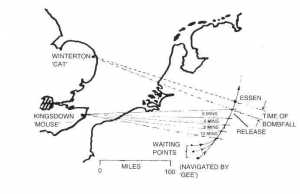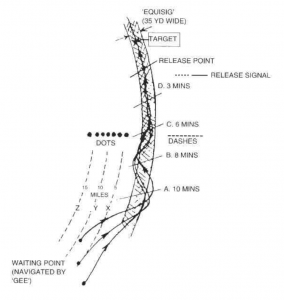OBOE Radar Navigation
There were several Oboe stations around the east and south coasts of England:
Sennen Cove and Treen, Landsend Cornwall.
Durlston Castle, Swanage, Dorset.
Deal x2, Kent.
Winterton and Trimmingham, near Cromer, Norfolk.
Cleadon, Durham.
Any of which could be nominated to perform a Cat or Mouse function depending on the target location .
OBOE
The inaccuracy of our all-weather bombing, especially at night, had been recognised for some time; something had to be done. Oboe was the brainchild of Alec Reeves,
the PCM (pulse code modulation) wizard of Standard Telephones and Cables Ltd and assisted by Frank Jones of TRE.
In 1940, Jones moved from Dundee to Worth Matravers and worked on the development of Oboe, the blind bombing radio navigation system, with Alec Harley Reeves.
He was head of the Oboe development team dealing with practical day to day management, while Reeves was more involved with the ideas 41. The basic principle of Oboe is really simple. The range of a target, say the Krupps armament works in Essen, measured from two widely spaced ground stations in the UK, was derived from pre-war ordnance survey maps and aerial
There were several Oboe stations around the east and south coasts of England: Sennen Cove and Treen, Landsend Cornwall; Swanage, Dorset; Deal x2, Kent; Winterton and Trimmingham, near Cromer, Norfolk and Cleadon Durham. Any of which could be nominated to perform a Cat or Mouse function depending on the target location The Early stations, MkI stations, became operational by Bomber Command in late 1942 used modified CHL equipment working on 200 MHz using pulse space modulation for signalling. This was superseded in early 1944 by the MkII working on 3Ghz or 10 centimetre.
The Swanage station, operational name Tilly Whim, was manned by TRE Pilot Officers from RAF Worth 39.
Oboe Upgrade
The MkI Oboe Navigation system was upgraded in early 1944 by a TRE team led by Mr F. E. Jones. The MkII worked on 3Ghz or 10 centimetre. A team of TRE scientist, who were formerly based at Leeson House, Swanage reviewed this new model and were disenchanted with its performance and was surprised with the results then being achieved. In early May 1944 the next mission was to bomb gun emplacements, a target a hundred time smaller that the train marshalling yards at Hamm Germany.
After reading the documentation the TRE team decided to examine an operational Oboe station’s equipment. At Walmer, Deal, they quickly found that the Master Oscillator was not accurate enough and the display strobe control, for the accuracy of all distance and air speed measurements, was very coarse and unstable. A member of the team, Reg Batt collected a new set of quartz crystals from the Post Office Research Department, Dollis Hill, North London and went to each of the stations training the Pilot Officers on how to install the modification using a master test oscillator that was two feet high and weighed 50 Kg, supplied by the Post Office. On the 27 May 1944, Swanage was the second station and Trimmingham, Norfolk, the last – that was on D-Day.
Oboe, Gee and H2S
The introduction of Oboe and then H2S would not come until the end of 1942 and would mark the beginning of the next phase of the bombing campaign. The evaluation tests took place in November 1942 using a combination of Oboe, GEE and H2S.
The H2S was installed in a Mosquito bomber flown by the Pathfinder Force (PFF); the bomber located the target area with GEE and Oboe, refined the exact location with ground mapping RADAR H2S and dropped coloured marker bombs accurately over the target area. These bombs burst at about 2000 ft, took 20 seconds to reach the ground and when on the ground burn for about five minutes, giving an unmistakable display for the proceeding bombers. The marker display time was lengthened by deploying more PFF bombers repeating the action every 10 minutes, to ensure there was no conflict between each PFF bomber’s Cat and Mouse transponder signals; the overall effect was a marker that lasted 40 minutes. This tactic proved very effective whilst bombing targets far away, outside of the range of GEE 42.
Method of Operation
One ground station, code-named CAT, controlled the track of the marker aircraft, usually a Mosquito, by interrogating an on-board transponder located on the Mosquito.
The Mosquito flew on a circular arc centred on the station at a radius equal to the target range, appeared stationary on the tube face located at CAT station, i.e. zero radial velocity. The purpose of the CAT was to keep the returned pulse exactly in line with the target marker strobe by automatically signalling dots or dashes to the Mosquito; dots if the Mosquito range was less than the target range, dashes if it was greater. The dots and dashes merged into a continuous note when the Mosquito range was correct.
The sensitivity of the system was such that a deviation of plus or minus 17 yards from the circular arc would cause either dots or dashes to be sent, thereby enabling the pilot to steer along an invisible track some 35 yards wide in the sky above the target.
The other ground station, code-named MOUSE, signalled the Mosquito as it passed a number of ‘milestones’ or countdown time to target along the arc until it reached the release point – the intersection of the Cat and Mouse ranges when the bomb release signal (five dots and a dash) was given automatically. Like the Cat station, the target was set by a strobe on a CRT with a delayed, magnified time base. Unlike the Cat, the returned pulse moved along the trace as the Mosquito approached the target region.
The precise release point was influenced by many factors e.g. time of bomb fall, trail distance, a function of bomb ballistics and airspeed, meteorological data, the velocity and heading of the Mosquito just prior to release plus instrumental corrections. These were taken into account by the Mouse computer the release point being continuously and automatically corrected to ensure that the predicted impact point of the bomb (or Target Indicator) was within the target zone 43.

